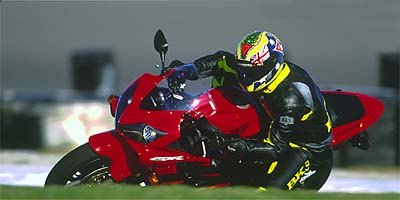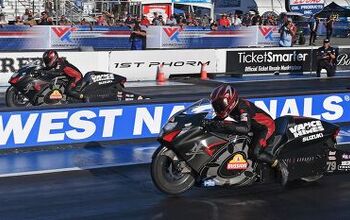First Ride: 2001 Honda CBR600F4i - Motorcycle.com
Las Vegas, NV, December 20, 2000 -- With Yamaha's track-honed R6 and Suzuki's equally sharp GSX-R600 garnering the majority of media attention, it's a shame when a great all-'rounder like Honda's newest CBR600, the F4i, gets left out of the spotlight. It doesn't deserve to, really. And after getting to spend the better part of a crisp winter day on Las Vegas' infield racetrack, we are even more confuzzled as to why this bike doesn't get the love it truly deserves.
As Honda's Gary Christopher was quick to point out, no other market segment has driven sportbike sales - up 21% this year - like the 600 sector. Both he and Honda's Peter TerHorst acknowledge that the F4i is still not a race-replica, but more of a "supersport for the street."
To stave off the competition, however, they point out how the new model is "more of a track machine" than the previous versions.
Doug Toland and his group of technicians addressed the main complaints of consumers and then went a step further by fuel injecting the 599 cc inline four to take advantage of a few other mods.
Starting with what was an already competent package, Honda made the new F4i an even sharper tool without sacrificing ride-ability. Starting with the externals, the new F4i receives an entirely new front fairing that resembles Yamaha's R6 but retains some very Honda-esque styling cues. The left H7 bulb illuminates things all by itself until the high-beam is activated, at which point the right light comes on as well. The new bodywork reduces drag by three percent and the new bulbs are 40-percent brighter than the old H4 bulbs.
These extra rpm come from a few internal changes that also allow the motor, claims Honda, to rev quicker than before. To keep things cool at the accelerated rev ceiling, the oiling holes in the camshafts have been enlarged by 0.5 mm (to 2.5 mm) and piston ring friction has been decreased as well.
Spring pressure on the intake and exhaust valves has been increased to avoid dreaded valve float. Also, there are now two valve springs (inner and outer) on the intake side instead of the single item that resides on the exhaust side. The camshaft sprocket is lighter this year, as well, to keep things spinning freely.
"The new frame is now beautiful in black and sports an increase in overall rigidity by 5.9 percent."
Also not the large intakes. Because of the new Fuel Injection in place of the F4's bank of carburetors, the engineers were left with a choice: more airbox capacity (more power) or a larger fuel tank (more range). Doug Toland and his test riders wanted more power, but this created a problem in the form of noise regulations.
The end result of that squabble is, like the rest of the bike, a compromise between track performance and on-road goodness. The new F4i has a tank that's one liter larger than the old version and it has an airbox that grew by two liters, to fifteen. Resonators were employed to keep noise levels down and airflow up, keeping the decibel people appeased.
The injectors that make up the i in F4i reside one per cylinder and work with 38 mm throttle bodies. The injectors have four nozzles each. They provide not only more efficient metering of the all-important fuel-air mixture, they also allow for a more efficient burn (the California model meets CARB 2004 emissions standards through the use of a catalyzer that drops two peak horsepower), and the choke lever has gone the way of the the kick starter. All these internal mods add up to a claimed five horsepower increase over the previous version.
The new horsepower is contained within a chassis that sports ia five millimeter shorter wheelbase with a 5.9-percent increase in overall rigidity. Unsprung weight has also been reduced quite a bit due to the shaving of a few hundred grams off of key components.
Minime found the newest iteration of the CBR600 to retain its ease-of-use while upping its racetrack potential. This is going to be a tough-to-beat overall package.For instance, the rear wheel lost 400 grams, the cush drive lost a whopping 600 grams and the front wheel lost 300 grams. Each caliper carrier also lost 100 grams a piece and the new design is supposed to provide better feel at the lever under hard braking.Starting out the day on Michelin's excellent Pilot Sport tires, we re-familiarized ourselves with Vegas' track layout following Jeff Haney, past factory Honda racer and third place Daytona 200 finisher who is also the lead instructor at Freddie Spencer's riding school. His lines got us back up to speed as we noticed that the newest CBR iteration retained something that has long been a staple of this particular Honda line: It's just about the easiest supersport bike to ride fast, on the street or on the race track. With tires warmed up and adrenalin flowing, the pace increased and the Moto Journalist GP, er, testing, got underway.
New dash layout includes a shift light and a new tach to better suit the higher-revving motor. The 38 mm throttle bodies are big part of the smooth-working fuel-injection system.You know you're at Vegas when you come out of either of the two tight lefts that lead onto a flatter and longer left that criss-crosses a slick paint stripe as it opens up onto either side of the speedway's banking. The whole time you're bending the bike over, throttle open and banging gears with your knee firmly planted on the pavement in excess of 120 mph before you pick the bike up for the final drive up onto the banking.Going deep into the corners, trail-braking off of the banking, front end feel was, again, very good. The only time anything unsettling occured was the occasional front end chatter that some riders noticed here. It never completely went away, even after fitting Michelin Pilot Race radials for the afternoon sessions. Might have been a bit of fork flex, but it never got to a point where it was much of a concern. It was only a minor nuisance for some.
The only real concern was regarding the front brakes, particularly slowing down from top speed while still on the banking. After only a few hard laps, the brake lever would work its way back into the fingers that remained on the grip. Honda's engineers swapped pads on our test bike and sent us back out, only to have a similar situation occur after another handful of laps.
The new CBR600F4i will be on showroom floors in your choice of three flavors: red/black, red/white, and silver/black. All look mighty tasty. A few journalists were worried when they took a spin on the old F4 and noted that the brakes on the older bike worked better than the new bike we just stepped off of. Then we hopped on a different F4i test bike with solid, powerful brakes. Weird.
If the front brakes we felt on some of the good test bikes are an indication of what production bikes will be like, however, then they'll be just fine for most riders. Racers, however, will have to consider a pad and brake line upgrade if they hope to scrub speed with the likes of Yamaha and Suzuki.
The new motor definitely feels more free-revving than the old unit. The new shift light on the tach is also a cool feature, though it would have to be brighter to be of much use in direct sunlight.
Gun-shy due to some fuel-injected offerings from manufacturers with glitchy throttle response as standard equipment, we were pleased to find that Doug Toland and his group of technicians did a nice job with the mapping on the Honda. Through a long, tight right-hander that doubles back on itself, the fastest line through is to drift out mid-corner, then ease off the throttle to pinch the bike back down, getting it squared up for the drive out onto the short chute before the next right-hand kink. At the moment that you ease out of the throttle and feather it on as you roll the bike down to the apex, a glitch could spell certain disaster. Thankfully, this never became an issue.
We came way from Las Vegas impressed with the latest Supersport contender from Honda. If another title is in the cards for Kurtis Roberts this year, this is the bike you'll see in the winner's circle.Low-speed response also seemed well-dialed during the warm-up laps and during the few times we slowed down enough to make a point of testing low-speed response. There wasn't the common hitch when winding the throttle on at low rpm. So, with the added horsepower and lower emissions, it seems that placing the old carbs on the same theoretical shelf as the old NR750's oval pistons wasn't such a bad idea after all.
Specifications
Model : CBR600F4iEngine Type : 599cc liquid-cooled inline four-cylinderBore and Stroke : 67mm x 42.5mmCompression Ratio : 12.0:1Valve Train : DOHC; four valves per cylinderCarburetion : PGM-FI with automatic chokeIgnnition : Computer-controlled digital transistorized withthree-dimensional mappingTransmission : Close-ratio six-speedFinal Drive : #525 O-ring-sealed chainSuspension : Front : 43mm HMAS cartrige fork with spring preload,rebound and copression damping adjustability;4.7 inches travel. Rear : Pro-Link HMAS single shock with spring preload,rebound and compression damping ability;4.7 inches travel.Brakes : Front : Dual 296mm discs with four-piston calipers. Rear : Single 220mm disc.Tires : Front : 120/70ZR-17 radial.Rear : 180/55ZR-17 radial.Wheelbase : 54.5 inchesRake (Caster Angle) : 24.0 degreesTrail : 96mm (3.8 inches)Seat height : 31.7 inchesDry Weight : 370 poundsFuel Capacity : 4.8 gallons, including 0.9-gallon reserveColors : Red/Black, Pearl White/Red, Metallic Silver/BlackMeets CARB 2004 emissions standards.
More by MO Staff


































Comments
Join the conversation